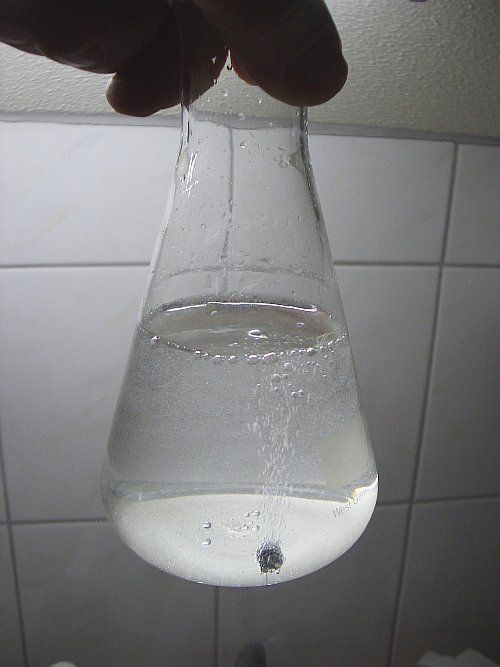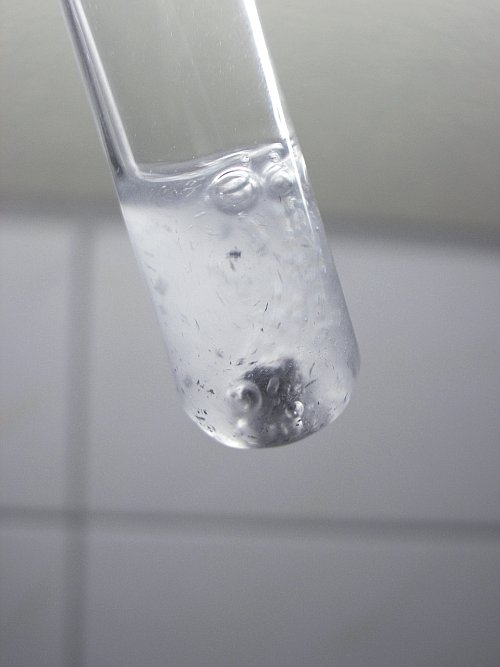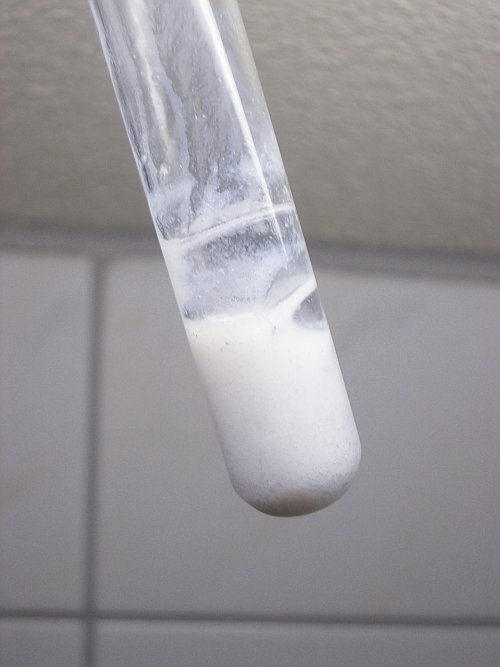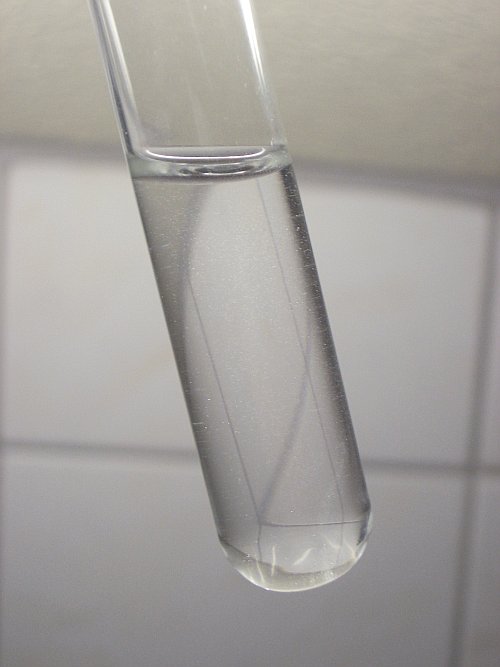


Reaction of calcium metal with water
When the reaction between a metal and water is demonstrated, then frequently the reaction between sodium and water is shown. That reaction is violent and as such is quite spectacular. However, the reaction with calcium demonstrates some nice aspects of chemistry, which are not demonstrated by the reaction between sodium and water.
![]()
![]() Required
chemicals:
Required
chemicals:
-
calcium metal, pea sized granules
-
water
-
dilute hydrochloric acid (approximately 10% HCl by weight)
![]() Required
equipment:
Required
equipment:
-
test tubes
-
large erlenmeyer or beaker
![]() Safety:
Safety:
- dilute hydrochloric acid is corrosive.
- calcium metal is quite reactive and when it is in contact with skin, caustic calcium hydroxide may be formed.
- the reaction in the test tube becomes very violent, be careful.
- do not scale up this experiment, this is a reaction, which can easily go out of control on a larger scale!
![]() Disposal:
Disposal:
- The waste can be flushed down the drain with a lot of water.
![]()
Calcium added to a large amount of water
Put a pea-sized granule of calcium in a large erlenmeyer or beaker, full of water. Using 300 to 500 ml of water is perfect. Tap water is suitable. When the granule is added, then hydrogen gas is produced at a nice constant rate. The water becomes slightly turbid, due to formation of sparingly soluble calcium hydroxide and possibly other calcium salts, when tap water is used. The result is shown here:

The rate of reaction remains the same, until the granule of calcium has dissolved. The water does not noticeably heat up.
![]()
Calcium added to a small amount of water
Now, the same experiment is repeated, but now a few ml of water is used in a test tube instead of several hundreds of ml of water. The pea-sized piece of calcium is put in the test tube with water.
Initially, the rate of reaction is comparable to that, observed in the large erlenmeyer, but quickly the reaction becomes more violent. At a certain point, the reaction becomes so violent that there is a risk of the contents of the test tube being swirled away. While the calcium reacts, a thick white precipitate is formed. The contents of the test tube also becomes very hot.
Suddenly, the reaction comes to a halt almost completely, while still quite some calcium is left. Only very slow bubbling remains. This is the second phenomenon, not observed in the erlenmeyer. The two pictures below show the somewhat more violent reaction of the calcium and the water with white precipitate. Inside the precipitate there still is a fairly large chunk of calcium. This cannot be seen, but by swirling the test tube, one can hear and feel the metal touching the glass wall of the test tube.


When a large excess amount of dilute hydrochloric acid is added, then the remaining calcium dissolves, also quite violently, and the liquid becomes clear and hot. After the reaction, a completely clear liquid remains with some very small bubbles left in the liquid, which slowly go towards the surface.

![]()
Discussion of results
![]() Calcium
metal reacts with water as follows:
Calcium
metal reacts with water as follows:
Ca(s) + 2H2O → Ca2+(aq) + 2OH–(aq) + H2(g)
Calcium hydroxide, Ca(OH)2, however, is only sparingly soluble in water. A white precipitate of solid calcium hydroxide is formed.
In the erlenmeyer, the amount of calcium, relative to the amount of water, is very small. Almost all calcium hydroxide remains in solution. In the test tube, however, most of it is precipitated and this precipitate forms a layer around the piece of calcium metal. This layer makes it harder for the water to reach the calcium metal. This is the reason, why the reaction comes to a halt almost completely, while still quite some calcium is left.
The reaction between calcium and water is quite exothermic. In the large erlenmeyer, the heat produced hardly is noticed, but in the test tube it causes the water to heat up considerably. Due to this higher temperature, the reaction goes faster. This very nicely demonstrates that a reaction goes faster at higher temperature. This kind of reactions also can become quite dangerous, because initially the reaction is slow and unexpectedly, the reaction can show thermal runaway and one can loose control over the experimental setup. For this reason, this reaction should not be scaled up.
When acid is added, then the calcium hydroxide dissolves again and water and acid can freely reach the remaining calcium metal again, causing it to dissolve quickly. The final liquid is clear and colorless. It contains Ca2+(aq) ions, which are colorless.